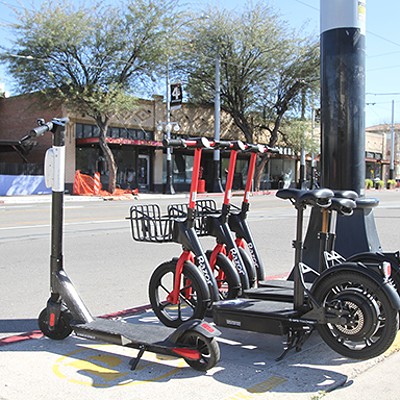One of the plan's recommendations was to build an overpass above the tracks at Campbell Avenue near 22nd Street. Another was to widen the downtown Sixth Avenue underpass from two to four lanes. It took 40 years before the first suggestion was implemented, and the second is still pending more than 55 years later.
During the 1980s, with great fanfare, the City prepared and approved a study on the future of Broadway Boulevard. It also adopted a program for widening Grant Road. In the early '90s, the City laid out a plan for turning Speedway Boulevard into a six-lane street between Euclid and Stone avenues.
At the same time, the City got into the model-building business. It commissioned elaborate and expensive displays of the Broadway Corridor, the proposed grade-separated interchange at Campbell and Grant, and the last mile of the Barraza-Aviation Parkway.
None of these projects, of course, has ever been accomplished. Both the plans and the models now just gather dust. Despite that, the City of Tucson continues to plan for future roadway improvements, whether it has the money to implement them or not.
Paul Mackey, who recently served on the citizen committee overseeing the preparation of a study for the future of Fifth/Sixth Street, believes it is time to do less planning and more building. Mackey says of the City's tendency to do transportation planning without project implementation, "A lot of it seems to be consultant welfare. We seem to be doing studies, but when are we going to decide which ones get funded and built?"
Mackey says the recommendations on Fifth/Sixth Street should be presented to the City Council this fall and will suggest keeping the roadway basically as it is now, but having priority transit lanes on the outside of the street along with bikeways. The City intends to coordinate with individual neighborhoods along the corridor on implementing the plan's landscaping and other proposals.
Mackey thinks the idea behind the $144,000 study was good, but the process never came to grips with the tough issues. In his opinion, at least one-third of the money spent on the study was wasted on unnecessary consultant work.
BENNY YOUNG disagrees. The director of the City's transportation department until 1996, when he was promoted to Assistant City Manager, Young is once again overseeing the department until a new director can be named. That is something he doesn't expect to happen before the end of the year.
"Every good public works project starts with good planning," Young said in his tenth floor City Hall office. "The Fifth/Sixth Street process has resulted in agreement on landscaping, designation of the street as an education corridor, and the need for pedestrian improvements and improvements to transit service. I think planning money is money well spent, and it saves taxpayers money in the long run."
Young also defends the City against criticism about the types of streets it does occasionally build. Whether it is the $56 million Speedway Boulevard project between Euclid and Alvernon, the Mountain Avenue improvements from Speedway to Grant, or south Sixth Avenue north of Irvington to 18th Street, for more than a decade the city has constructed streets that add very little to the transportation system's capacity, but look very attractive. They are also expensive.
"It's a quality-of-life issue," Young insists. "Streets should be appealing for not only motorists, but also pedestrians. They shouldn't just be asphalt schisms." Plus, Young adds, the percentage of money that goes to landscaping a project is minor compared to the total project cost. He estimates that approximately $750,000, or only six percent of the $13 million construction budget, was spent to beautify south Sixth Avenue with landscaping. On an upcoming project along Mountain Avenue between Grant and Ft. Lowell roads, $300,000 of the total $6.9 million will be used for landscaping, with most of the remaining funds going to fix the area's drainage problem.
On the subject of Pima County's bond-funded roadway program, County Supervisor Ann Day agrees with Young's philosophy. "Of course we have to mitigate projects with sound walls and install bike paths and landscaping next to neighborhoods," she says. "It costs something, but I think it is as much a part of a roadway project as anything else."
Longtime transportation observer Steve Emerine points out, however, that planting isn't the only expense of landscaping. "The cost of maintenance for landscaping may be considerably more than the original installation," he says.
Emerine has also loudly complained for years about the City's decision a decade or more ago to restripe several mid-mile streets. Tucson Boulevard, Columbus Boulevard and Glenn Street all went from four to two lanes with a center turn lane and outside bike paths added. "The restriping was a terrible waste of traffic capacity when you see how much an additional lane of street costs to build," the former newspaperman and county official says. "We're way behind our funding needs, but we gave up money this way."
City officials have supported their decisions by saying the extra lanes weren't needed for traffic capacity, while the restriping provided for safer turning movements and better bicycle circulation.
They also defend themselves against criticism for not taking advantage of small opportunities to improve the transportation system.
Recently a frustrated Tucsonan asked why the City didn't build, or require the developer to install, a bus pullout on the southeast corner of Broadway Boulevard and Country Club Road. This location, where a new building is now under construction, would seem to be an ideal candidate for such a feature. It would allow some of the almost 22,000 eastbound cars a day on Broadway to avoid a stopped bus.
But Young says the City couldn't ask the developer to install a pullout. That long-ago adopted Broadway corridor plan calls for the south side of the street to someday have a dedicated transit lane. So even though the plan may never be implemented, as long as it is in place, the City can't require a pullout where a "bus-only" lane might eventually exist someday.
That decision will probably perplex stalled motorists breathing exhaust fumes as they sit behind a bus on Broadway. As for addressing Tucson's transportation problems, Sam Hughes resident Paul Mackey concludes of the City's approach, "I'm tired of hearing City officials say, 'We need more money.' There is no transportation solution in sight, and to talk about one is just nonsense with our present development pattern. The best we can do is make a dent, but let's make some dents instead of doing more studies."











